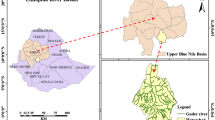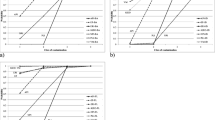Abstract
Spatial analysis and fuzzy classification techniques were used to estimate the spatial distributions of heavy metals in soil. The work was applied to soils in a coastal region that is characterized by intense urban occupation and large numbers of different industries. Concentrations of heavy metals were determined using geostatistical techniques and classes of risk were defined using fuzzy classification. The resulting prediction mappings identify the locations of high concentrations of Pb, Zn, Ni, and Cu in topsoils of the study area. The maps show that areas of high pollution of Ni and Cu are located at the northeast, where there is a predominance of industrial and agricultural activities; Pb and Zn also occur in high concentrations in the northeast, but the maps also show significant concentrations of Pb and Zn in other areas, mainly in the central and southeastern parts, where there are urban leisure activities and trade centers. Maps were also prepared showing levels of pollution risk. These maps show that (1) Cu presents a large pollution risk in the north–northwest, midwest, and southeast sectors, (2) Pb represents a moderate risk in most areas, (3) Zn generally exhibits low risk, and (4) Ni represents either low risk or no risk in the studied area. This study shows that combining geostatistics with fuzzy theory can provide results that offer insight into risk assessment for environmental pollution.






Similar content being viewed by others
References
Alloway BJ (2001) Heavy metals in soils. Wiley, New York
Amini M, Afyuni M, Fathianpour N, Khademi H, Flühler H (2005) Continuous soil pollution mapping using fuzzy logic and spatial interpolation. Geoderma 124:223–233. doi:10.1016/j.geoderma.2004.05.009
Burrough PA (1992) Development of intelligent geographical information systems. Int J Geogr Inf Sci 6:1–12. doi:10.1080/02693799208901891
Burrough PA, Mcdonell R (2004) Principles of geographical information systems. Oxford University Press, Oxford
Burrough PA, Van Gaans P, Hootsmans RJ (1997) Continuous classification in soil survey: spatial correlation, confusion and boundaries. Geoderma 77:115–136. doi:10.1016/S0016-7061(97)00018-9
Cambardella CA, Moorman TB, Novak JM, Parkin TB, Turco RF, Konopka AE (1994) Field-scale variability of soil properties in central Iowa soils. Soil Sci Soc Am J 58:1501–1511
Carnelo LGL, de Miguez SR, Marba’n L (1997) Heavy metals input with phosphate fertilizers used in Argentina. Sci Total Environ 204:245–250. doi:10.1016/S0048-9697(97)00187-3
Cattle AJ, McBratney AB, Minasny B (2002) Kriging methods evaluation for assessing the spatial distribution of urban soil lead contamination. J Environ Qual 319:1576–1588
CETESB (2001) São Paulo State Basic Sanitation and Technology Company. Relatório de estabelecimento de valores orientadores para solos e águas subterrâneas no Estado de São Paulo. CETESB, São Paulo, p 70
Chang L, Burrough PA (1987) Fuzzy reasoning: a new quantitative aid for land evaluation. Soil Surv Land Eval 7:69–80
Chang YH, Scrimshaw MD, Emmerson RHC, Lester JN (1998) Geostatistical analysis of sampling uncertainty at the Tollesbury managed retreat site in Blackwater Estuary, Essex, UK: kriging and cokriging approach to minimize sampling density. Sci Total Environ 221:43–57. doi:10.1016/S0048-9697(98)00262-9
Chien YL, Lee DY, Guo HY, Houng KH (1997) Geostatistical analysis of soil properties of mid-west Taiwan soils. Soil Sci 162:291–297. doi:10.1097/00010694-199704000-00007
De Gruijter JJ, Walvooer DJJ, Van Gaans PFM (1997) Continuous soil maps: a fuzzy set approach to bridge the gap between aggregation levels of process and distribution models. Geoderma 77:169–195. doi:10.1016/S0016-7061(97)00021-9
Dias NL, do Carmo DR, Rosa AH (2006) Selective sorption of mercury (II) from aqueous solution with an organically modified clay and its electroanalytical application. Sep Sci Technol 41:733–746. doi:10.1080/01496390500526896
Dobermann A, Oberthür T (1997) Fuzzy mapping of soil fertility a case study on irrigated riceland in the Philippines. Geoderma 77:317–339. doi:10.1016/S0016-7061(97)00028-1
Feng Qi, A-Xing Zhu, Harrower M, Burt JE (2006) Fuzzy soil mapping based on prototype category theory. Geoderma 136:774–787. doi:10.1016/j.geoderma.2006.06.001
Franssen H, Eijnsbergen AC, Stein A (1977) Use of spatial prediction techniques and fuzzy classification for mapping soil pollutants. Geoderma 77:243–262. doi:10.1016/S0016-7061(97)00024-4
Goovaerts P (1997) Geostatistics for natural resources evaluation. Oxford University Press, Oxford
Gringarten E, Deutsch CV (2001) Teacher’s aide: variogram interpretation and modeling. Math Geol 33:507–534. doi:10.1023/A:1011093014141
Isaaks E, Srivastava RM (1989) An introduction to applied geostatistics. Oxford University Press, Oxford
Jiang H, Eastman JR (2000) Application of fuzzy measures in multi-criteria evaluation in GIS. Int J Geogr Inf Sci 14(2):173–184. doi:10.1080/136588100240903
Journel AG, Huijbregts C (1978) Mining geostatistics. Academic Press, London
Landim PMB (2003) Statistical analysis of geological data. Ed. UNESP, São Paulo
Lin YP, Chang TK, Teng TP (2001) Characterization of soil lead by comparing sequential Gaussian simulation, simulated annealing simulation and kriging methods. Environ Geol 41:189–199. doi:10.1007/s002540100382
Liu XM, Wu JJ, Xu JM (2006) Characterizing the risk assessment of heavy metals and sampling uncertainty analysis in paddy field by geostatistics and GIS. Environ Pollut 141:257–264. doi:10.1016/j.envpol.2005.08.048
Lourenço RW, Landim PMB (2005) Risk mapping of public health through geostatistics methods. Rep Public Health 21(1):150–160
McBratney AB, De Gruijter JJ, Brus DJ (1992) Spatial prediction and mapping of continuous soil classes. Geoderma 54:39–64. doi:10.1016/0016-7061(92)90097-Q
McGraph D, Zhang CS, Carton O (2004) Geostatistical analyses and hazard assessment on soil lead in Silvermines, area Ireland. Environ Pollut 127:239–248. doi:10.1016/j.envpol.2003.07.002
Moreira-Nodermann LM (1987) Geochemistry and environment. Geoquímica Brasilienses 1:89–107
Odeh IOA, McBratney AB, Chittleborough DJ (1992) Fuzzy-c-means and kriging from mapping soil as a continuous system. Soil Sci Soc Am J 56:1848–1854
Olea RA (1999) Optimum mapping techniques using regionalized variable theory. Kansas Geological Survey, Kansas
Rocha JC, Sargentini E, Zara LF, Rosa AH, dos Santos A, Burba P (2003) Reduction of mercury (II) by tropical river humic substances (Rio Negro). Part II. Influence of structural features (molecular size, aromaticity, phenolic groups, organically bound sulfur). Talanta 61:699–707. doi:10.1016/S0039-9140(03)00351-5
Romic M, Romic D (2003) Heavy metals distribution in agricultural topsoils in urban area. Environ Geol 43:795–805
Shi J, Wang H, Xu J, Wu J, Liu X, Zhu H, Yu C (2007) Spatial distribution of heavy metals in soils: a case study of Changxing, China. Environ Geol 52:1–10. doi:10.1007/s00254-006-0443-6
Stein J, Schettler T, Wallinga D, Vallenti M (2002) In harm’s way: toxic threats to child development. J Dev Behav Pediatr 1(Suppl 1):S13–S22
Tang HW, Huel G, Compagna D, Hellier G, Boissinot C, Blot P (1999) Neurodevelopment evaluation of 9-month old infants exposed to low levels of Pb in vitro: involvement of monoamine neurotransmitters. J Appl Toxicol 19:167–172. doi:10.1002/(SICI)1099-1263(199905/06)19:3<167::AID-JAT560>3.0.CO;2-8
Van Gaans PFM, Burrough PA (1993) The use of fuzzy logic and continuous classification in GIS applications. In: Harts JJ, Ottens HFL, Scholten HJ (eds) Proceedings of UGIS’93, Utrecht, Amsterdam
Van Meirvenne M, Goovaerts P (2001) Evaluating the probability of exceeding a site-specific soil cadmium contamination threshold. Geoderma 102:63–88. doi:10.1016/S0016-7061(00)00105-1
Webster R, Oliver MA (2001) Geostatistics for environmental scientists. Wiley, Chichester, pp 89–96
Winneke G, Walkowiak J, Lilienthal H (2002) PCB induced neurodevelopmental toxicity in human infants and its potential mediation by endocrine dysfunction. Toxicology 181–182:161–165. doi:10.1016/S0300-483X(02)00274-3
Yang HD, Nong SW, Cai SM (1995) Environmental geochemistry of sediments in Lake Dong Hu, Wuhan. Chin Sci Abstr Ser B 14:23
Yang JH, Derr-Yellin EC, Kodavanti PR (2003) Alterations in brain protein kinase c isoforms following developmental exposure to a polychlorinated biphenyl mixture. Mol Brain Res 111:123–135. doi:10.1016/S0169-328X(02)00697-6
Zadeh LA (1965) Fuzzy sets. Inf Control 8(3):338–353. doi:10.1016/S0019-9958(65)90241-X
Zhang CS, Selinus O (1998) Statistics and GIS in environmental geochemistry—some problems and solutions. J Geochem Explor 64:339–354. doi:10.1016/S0375-6742(98)00048-X
Zhang CS, Zhang S, Zhang LC, Wang LJ (1995) Background contents of heavy metals in sediments of the Changjiang River system and their calculation methods. J Environ Sci 7:422–429
Author information
Authors and Affiliations
Corresponding author
Rights and permissions
About this article
Cite this article
Lourenço, R.W., Landim, P.M.B., Rosa, A.H. et al. Mapping soil pollution by spatial analysis and fuzzy classification. Environ Earth Sci 60, 495–504 (2010). https://doi.org/10.1007/s12665-009-0190-6
Received:
Accepted:
Published:
Issue Date:
DOI: https://doi.org/10.1007/s12665-009-0190-6




